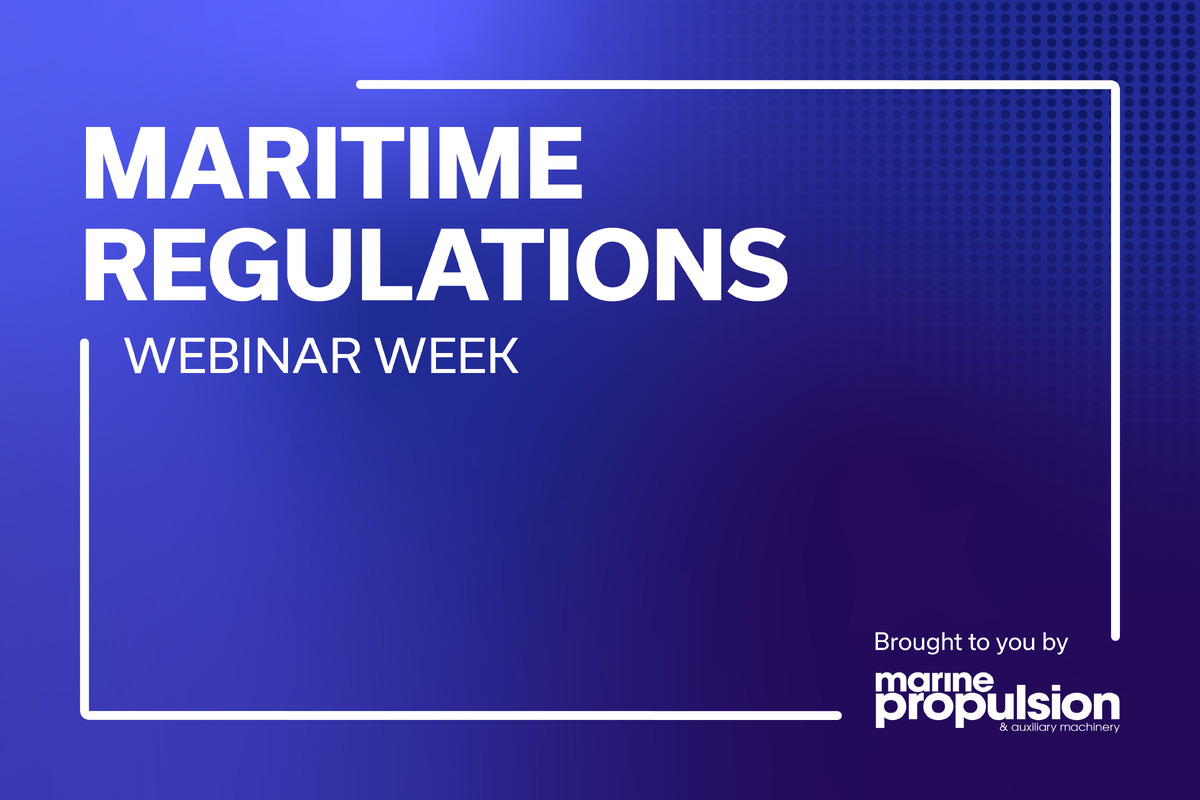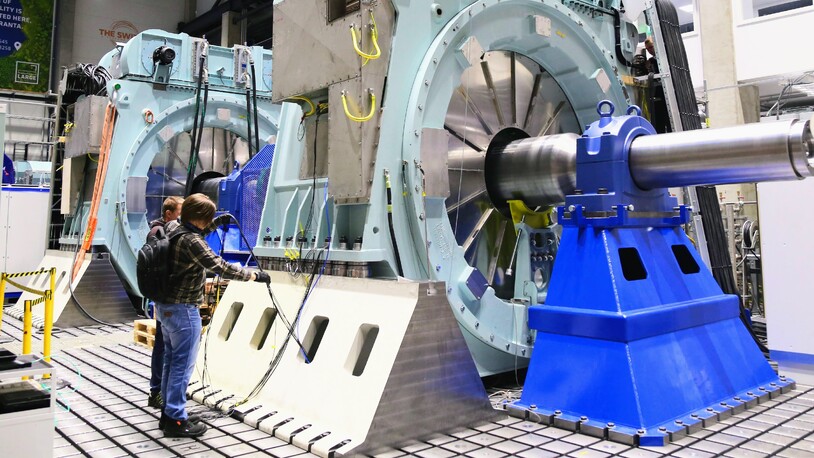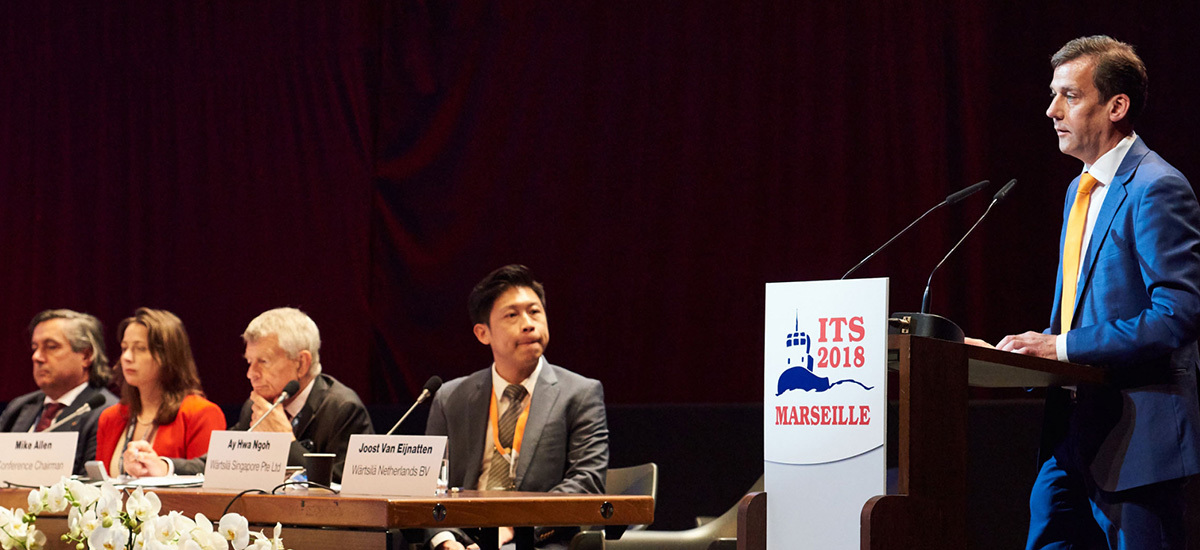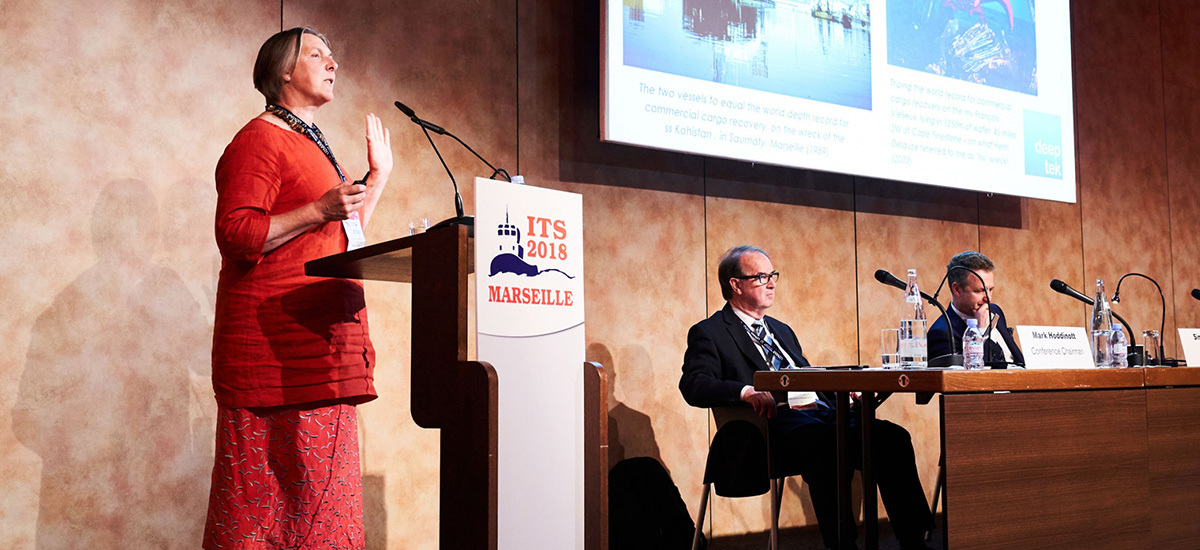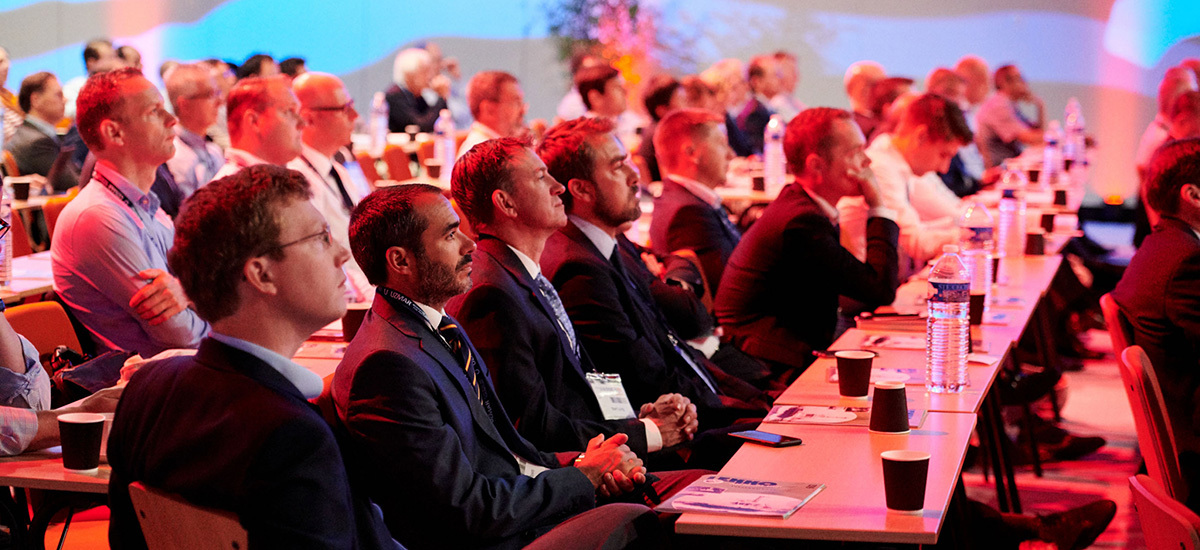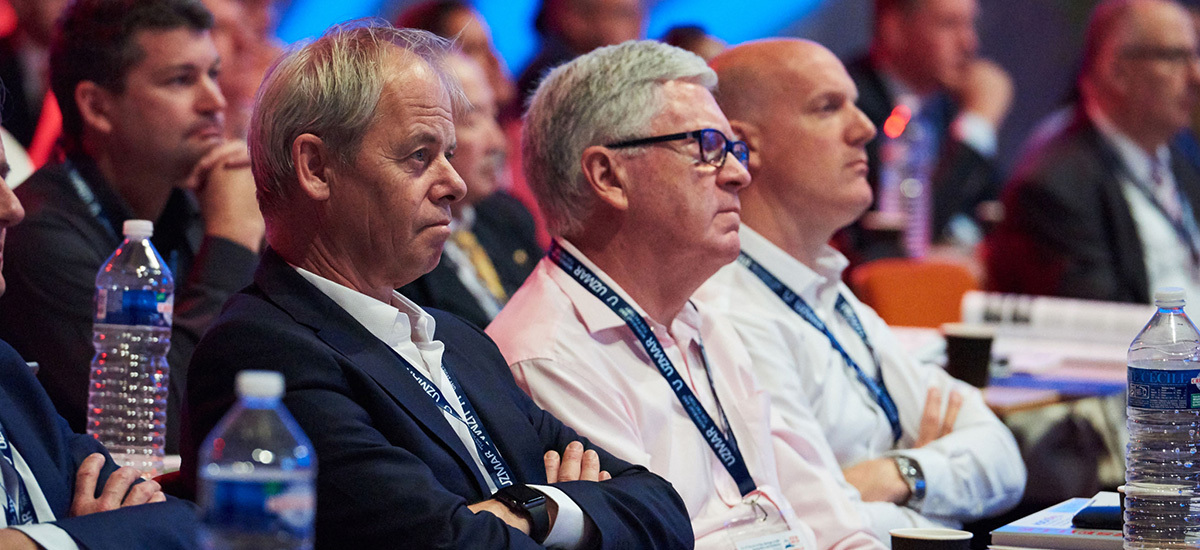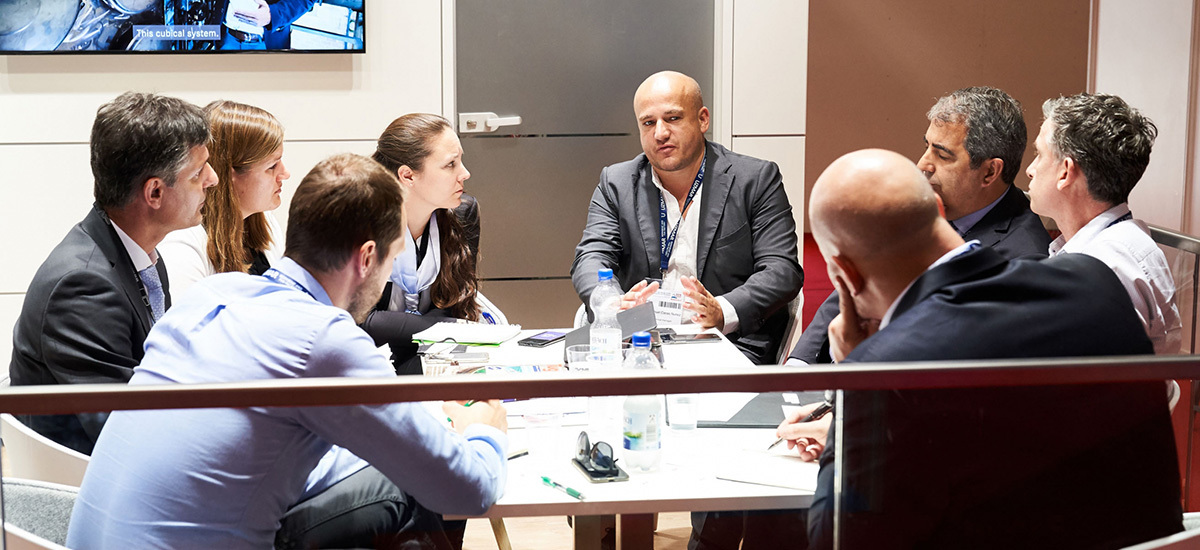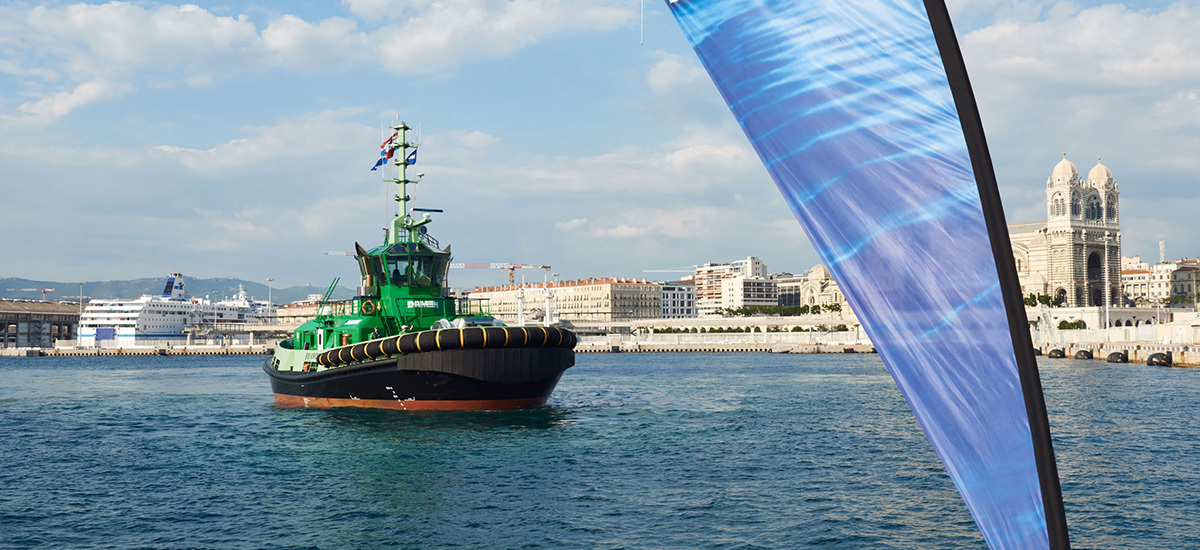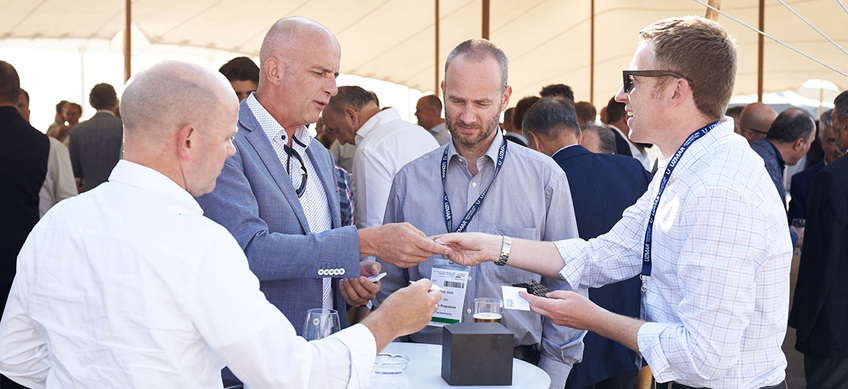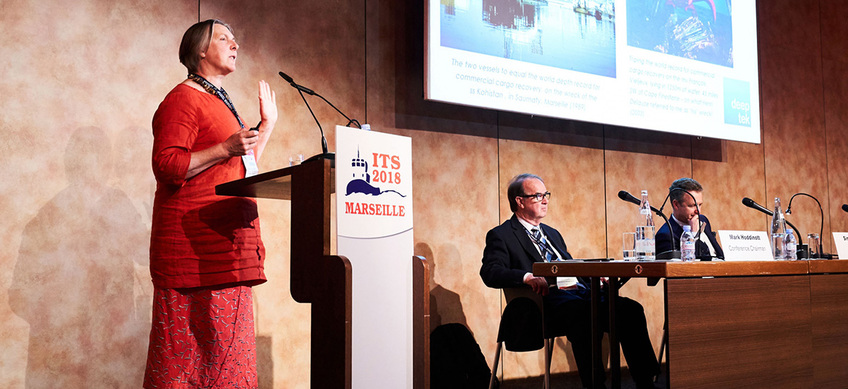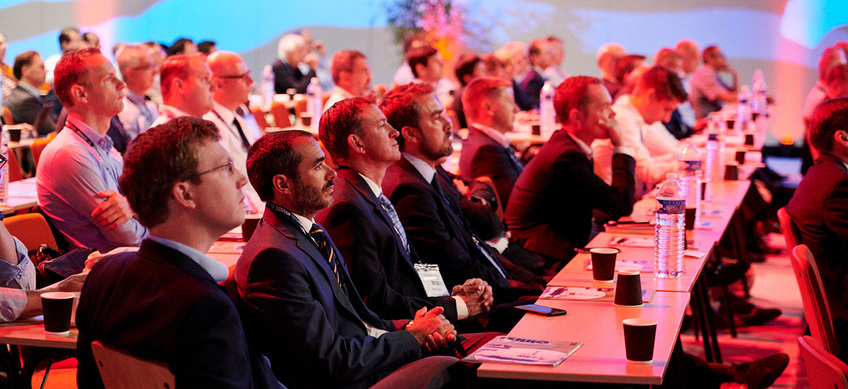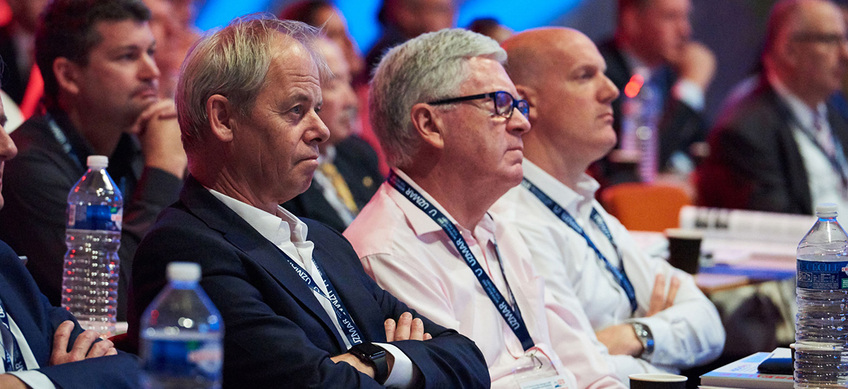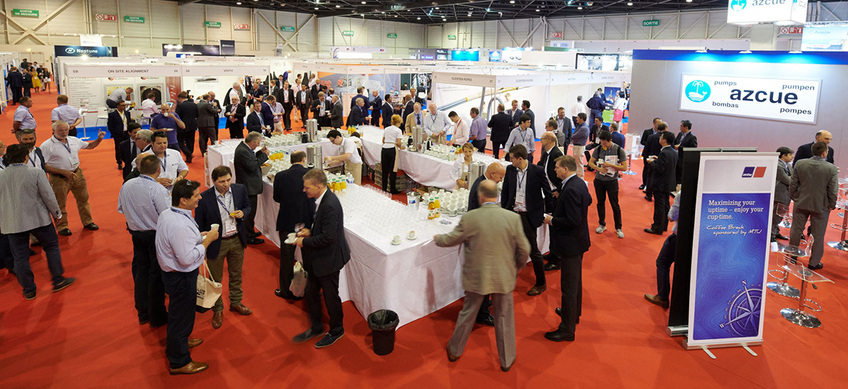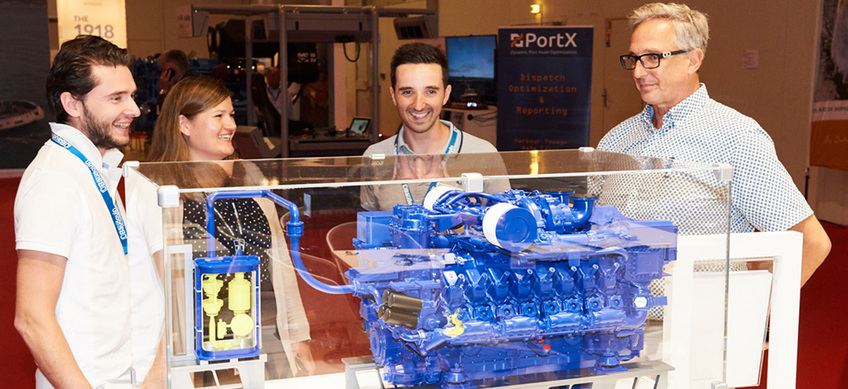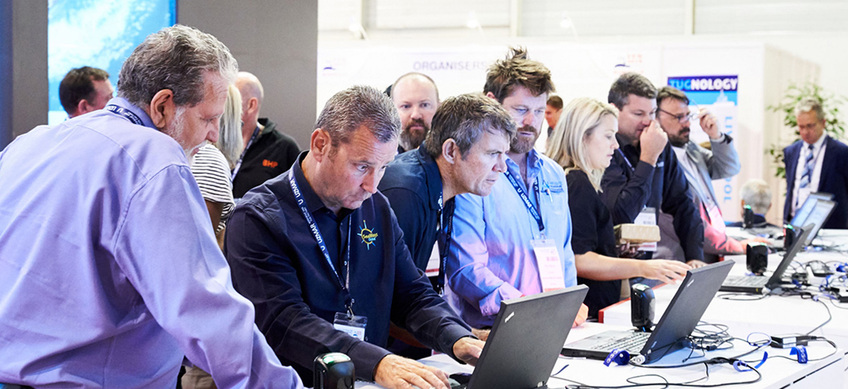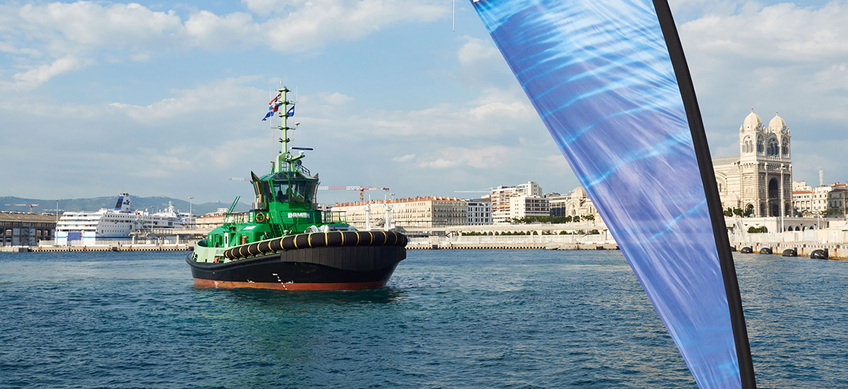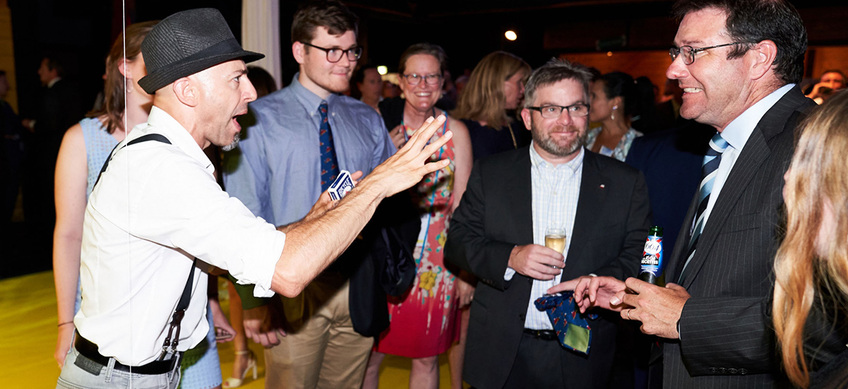ITS 2018 Marseille

ITS 2018 saw the future arrive as more than 1,300 attendees gathered in Marseille – the first time the event has been held in France.
Nigel Brunton-Reed, chairman of The ABR Company, officially welcomed delegates to the 25th convention in “the southern gateway to Europe”.
Nigel said he was delighted to welcome around 100 new delegates to the event along with long-term attendees, some of whom had been at our first convention in 1969.
Key themes to emerge over the week-long event included environmental impact and sustainable growth, admirably illustrated by keynote speaker Christine Cabau Woehrel, Présidente du Directoire Port de Marseille-Fos, the largest port in France. Addressing delegates on the first day of the conference about the importance of the shipping industry to the city, she said: “I have seen huge changes in the past 25 years and there will be further huge changes in the future – and Marseille will be a big part of that.
“Sustainable growth will be one of the biggest challenges for us – we will have to be greener and more efficient.”
Those themes – along with others covering hybrid technology, digitalisation, innovation, automation and safety among many others – were significant features in many of the 26 papers presented at ITS 2018 and in the discussions among delegates, visitors and exhibitors. For those with a specific interest in salvage matters, there was a dedicated session featuring five presentations focused on issues facing that sector.
Robert Allan’s scene-setting presentation to kick things off looked back at how ITS conventions have helped shape tug design over the past 50 years – as well as sparking forthright debate.
The advent of remote-controlled and autonomous vessels has been the subject of ITS discussions for many years – indeed, Allan’s paper and presentation identified 1988 as the first mention of them – but in Marseille delegates were literally able to get their hands on two examples now in operation.
Visitors to the combined stand of renowned innovators Rotortug and Alphatron Marine stood behind a Kotug captain as he operated the Kotug training tug RT Borkum situated in the Port of Rotterdam 1,200km to the north – although many of them initially thought they were watching a simulation rather than actual, real-time tug operations.
Meanwhile, at the stand of Rosetti Marino/Purple Water, a remote bridge command console was in use manoeuvring the tug Giano around Marseille port where it was berthed throughout the convention and exhibition.
Also berthed in the port – and making a dramatic appearance at the Damen-sponsored harbour-side welcome reception on the first day of ITS 2018 – was the Dutch shipbuilder’s Bis Viridis, a hybrid variant of its new RSD 2513 tug.
“It was an excellent event as always, a fantastic opportunity to catch up with all of the right people. I remain convinced that ITS and Tugnology are the best conferences in the industry, always the highlight of the year.”
Paul Jamer, Breakwater Group
While ITS has earned a reputation for the quality of the papers and presentations in the convention, it is also a place to do business – and the expansive exhibition hall played host to a steady stream of contract signings and presentations throughout the three days, with major industry players Novatug, Damen, Uzmar, Sanmar, Robert Allan Ltd, Ibercisa, Logan Clutch and TTC all celebrating significant announcements.
“An extremely good show, a great location and well attended. Well done to the ABR team, they did a fantastic job.”
Mark Gambell, Samson Rope
Also in the exhibition hall, former tug master and author Capt Henk Hensen, got a taste of the rock-star treatment as the launch of a comprehensive new edition of his book Tug Use in Port (published by The ABR Company) saw dozens of requests for purchased copies to be signed.
Out of the ITS spotlight, but still an important element alongside it, the Parc Chanot venue also played host to the latest bollard pull JIP meeting, which saw further progress on technical issues around this subject.
“Again, a great performance by the ABR team, excellent preparation resulted in the ITS quality that we now take for granted.”
Baldo Dielen, EDDY Tug
No review of an ITS event would be complete without mention of the varied and popular social events that form such an important part of the whole experience. As well as Damen’s welcome reception, an evening reception two days later, sponsored by Cashman Equipment, was held on the rooftop of part of Marseille’s extensively redeveloped harbour area, while the Caterpillar-sponsored Gala Dinner the following night took place in a former warehouse that perfectly captured the city’s vibrant reputation.
“It is always valuable to share news and ideas with others in the industry. There were excellent opportunities for meeting friends and networking.”
Robert Allan, Robert Allan Ltd
Back in the exhibition hall, end-of-the-day happy hours sponsored by Armon and Sanmar gave delegates and visitors the maximum opportunity to see exhibitors – including some with the brilliant strategy of switching video screens to live World Cup coverage. Delegate lunches throughout the event were sponsored by Uzmar, while all the tea and coffee breaks were sponsored by Rolls-Royce and MTU.
Delegates were delighted with this year’s smart conference bags, sponsored by Samson. Moteurs Baudouin sponsored a relaxed meeting zone within the exhibition hall, and the ITS web app was sponsored by Wärtsilä. Outside the conference centre, the IMS Run Club organised daily early-morning runs and walks around the streets of Marseille, and The Shipowners’ Club hosted an enjoyable boat trip and lunch on Friday, which rounded off the week in true ITS style.
“Yet another well organised quality convention bringing the ‘family’ back together again, well done and thanks.”
Brendan Cooley, IMS
“ITS has been a revelation. We would definitely exhibit again.”
Darren Rowlands, NRG Marine
The world’s largest gathering of Tug, Towage and Salvage experts
The ITS Convention and Exhibition started life as the International Tug Conference in 1969. At the 10th Conference in Sydney 1988, salvage was introduced into the programme for the first time, and the conference was renamed the International Tug and Salvage Convention and Exhibition.
The event, held every two years in a different location, is the world’s largest gathering of tug, towage, and salvage experts. Over the past 50 years, the convention has earned an enviable reputation for being the best of its kind. It attracts the most senior executives in the business, affording them a unique opportunity to meet, learn and discuss projects or contracts.
The convention has grown significantly and now attracts more than 1000 attendees and 100 exhibitors.
Since 1969, over 8,000 delegates and 1,200 exhibitors from 50 countries have taken part in the conventions.
"I realised that my entire career and the international success of our business have been inextricably linked with these conferences. Through them we have met the majority of our international clients, have been given the platform from which to draw attention to the important unique design developments initiated by this office, and been able to share ideas about the future of tug design and operations with a worldwide audience"
Robert Allan, Robert Allan Ltd
Programme
Official Opening & Inaugural Paper
CHRISTINE CABAU WOEHREL, Présidente du Directoire, Port de Marseille-Fos, France
The Evolution of Tug Design Through ITS Eyes
ROBERT ALLAN, Executive Chairman, Robert Allan Ltd, Canada
The proceedings of the previous 24 ITS Conferences, from 1969 to the present date, represent an unparalleled documentary record of the history and development of the modern tugboat and all its accoutrements. Being sourced from almost every conceivable sector of the international towing industry, these papers can truly be said to offer an unbiased accounting of the development of the modern tug, as well as its changing role in global shipping. In tribute to Allan Brunton-Reed, and to honour the 25th ITS Conference, the author looks back at some of the more salient papers presented to these conferences on the subject of tug design, and highlights how the modern tug has evolved, and the role that ITS has played in that growth and development.
Automation - What will be the Impact on the Insurance Sector?
BEN HARRIS, Head of Claims - London Branch, The Shipowners’ Protection Limited, UK
Autonomous vessels represent the latest evolution in a constantly evolving industry, one that could fundamentally change the seascape as we know it. While the impetus for change appears to have gained more traction recently, the trend represents a gradual shift brought about by advancements in technology that have decreased the number of crew required on board vessels. Arguably the driving force behind this change has not come from within the industry itself, but instead represents a wider trend towards the automation of all vehicles, on the basis that this will result in greater reliability and flexibility, as well as cost savings in the long run. Understandably, concerns remain over whether autonomous vessels are a safer alternative to manned vessels, as well as over heightened risks such as cybercrime. Despite these factors, autonomous vessels present an exciting opportunity, particularly to the small vessel sector, which is already embracing the change. P&I insurers will need to adapt to respond to the liabilities that their Members will face in connection with the ownership and operation of autonomous vessels.
World Port Tug Market - The Current View from Marseille
ALEC LAING, Managing Director/Shipbroker, ACL Shipbrokers Ltd, UK
The aim of the paper is to give an engaging, fresh and current view of the port tug market, specifically garnered and tailored to the ITS conference audience in Marseille. The presenter is Alec Laing, founder of ACL Shipbrokers, who works primarily in the port tug market. As an independent tug brokerage, ACL will use its access to key personalities in the market to canvas opinions from tug owners, designers and shipyards in the lead up to the conference. With this snapshot, the audience will be given a unique insight into the market, and a look to the future from market influencers. Before the conference in June, Laing will talk to the selected individuals, where possible face to face, to take the pulse of the market. The aim is to provide the audience with a more global perspective than they might be able to gather in their day to day jobs. Despite the advanced technology which our businesses benefit so much from, there is no substitute for meetings in person to discuss topical issues.
Quantum Physics Says There’s Life After Marseille
BALDO DIELEN, Partner, EDDY Tug, Brazil
How can the tug and OSV community surmount the myriad difficulties in the current market? There are so many technological solutions offered, but do we now need to start ordering unmanned, LNG-fuel cell driven hybrid OSVs or tugs with the latest cybersecurity technology and complex robotics? Why can’t we go back to the old days... or can we? This paper will show some ways ahead to simplify our lives (remembering that the bottom line is still as relevant as ever).
Ships’ Deck Fittings Utilised for Towage
CAPT ARIE NYGH, Managing Director, SeaWays Consultants Pty Ltd, Australia
There has been a move around the world to use high-powered escort tugs to ensure the safe passage of ships in restricted waterways. What has become apparent is that while these tugs can render significant assistance, there is an Achilles Heel - the ship’s fittings to which the towline is attached in many cases are unable to handle the forces generated by the tug. Investigation has found classification society regulations are confusing and lead to significant misunderstanding by pilots, tug masters and indeed ship owners. This potentially renders the whole exercise of escort towage a waste of time. This paper presents the issues, the underlying history of the situation, and comes up with some pragmatic guidelines to assist all concerned in making informed decisions.
The Digital Transformation of Tugs
DIRK DEGROOTE, Product Manager - Tugs, Damen Shipyards, The Netherlands
DANI MAROUANE, Digital IT Segment Architect, Damen Shipyards, The Netherlands
Digital transformation is shaping our world. In this paper, the impact and opportunities of this digital transformation for both the builder/designer and operator will be discussed. Digital transformation started with computer aided design, first in 2D and later in 3D. Over the last decade, this transformation speeded up with the increase of computational power and cloud computing, enabling more complex calculations and a better understanding of the behaviour of flows and structures. In line with market requirements, more compact and higher performance tugs with predictable sailing characteristics were the actual gains for the industry. Together with the increasing performance of these tugs, adequate handling with feedback on the vessels’ capabilities has become even more crucial to ensure safe operations. At the same time, operators are looking for digital solutions that offer remote troubleshooting, performance monitoring and condition-based maintenance, to increase the reliability of operations and to lower operating costs. To facilitate all this, Damen is enriching its tugs by adding sensors, and both extra hardware and software, to enable analysis and to give feedback on performance to the crew on board and on shore, providing an integrated solution for operators. This enrichment is, however, only the start, and will prove to be a platform for the shift to remote controlled and unmanned tug operations. The new generation of tugs, of which the RSD Tug 2513 Twin Fin is the most recent showcase, are ready for the next steps in this digital transformation.
Global Shipping Trends and the Carrousel RAVE Tug: Connecting the Dots
JULIAN OGGEL, Managing Director, Novatug BV, The Netherlands
In early 2018, a new tug type based on Dutch towage innovator Novatug’s patented Carrousel technology, the Carrousel RAVE Tug (CRT), was put into operation by Dutch towage operator Multraship. The CRT’s development has been driven by Multraship’s decades-long experience in towage and salvage. For the development of the CRT, Novatug has purposely been looking for a smarter solution than just adding installed power to tugs. The objective is for towage to add value to shipping as a driver for global trade in the face of the unmistakable trends towards larger ships, enhanced environmental and safety standards, and the demand for an optimal flow in the entire logistical chain. The CRT has been developed as a comprehensive answer to all of those concerns, operating within the capacity of existing maritime infrastructure and without demanding prohibitive further investments therein. We are honoured to present all the benefits of, and exclusively share, the first operational experience with the CRT at ITS 2018.
Considerations of Hybrid Technology & Associated Machinery
PAOLO SCIALLA, Lead Specialist Electrotechnical Systems, Lloyd’s Register EMEA, Italy
Technological advances in energy storage devices and distribution systems have seen further uptake in hybrid propulsion and powering solutions across a widening variety of marine applications. In this paper, the authors provide details of some of the challenges for this technology and the approaches made by Lloyd’s Register to provide the required level of industry assurance. Focus is made on the offshore and towage segment, covering aspects such as propulsion systems and bollard pull certification.
A Holistic Approach to the Optimised Design of Marine Hybrid Power Solutions for Workboat Applications
MARK WATSON, Sales & Sales Support Engineer, MAN Energy Solutions SE, Germany
JAN GLAS, Team Manager Application & Engineering Support, Schottel GmbH, Germany
JASON ASPIN, Chief Executive Officer, Aspin Kemp & Associates, Canada
Marine hybrid propulsion plants were seen as pure technology demonstrators a decade ago1. Today, in the wake of the trend taking hold in the automotive industry, hybrid systems are proving themselves theoretically superior to traditional marine propulsion trains with regard to operational expenditure (Opex). However, a breakthrough has not yet taken place, mainly due to higher capital expenditure (Capex) and a perceived high risk in certification, installation and operation. Taking up those challenges in a holistic approach, this paper presents the inherent flexibility and the innovative payload hybrid systems can bring to workboat applications. We show that hybrid systems are not just making current operations more effective and efficient, but are giving access to more sophisticated capabilities, paving the way for new modes of operation with a similar Capex to traditional arrangements. Such a holistic view requires a wide-ranging approach to system design, based on a synergy of highly specialised products and competences. Thus, merging together the engineering expertise of three industry-leading system providers, a practical example of such a holistic hybrid design is given, highlighting how it can be used to: - assess different vessel capabilities in regards to both Capex and Opex - improve load response capabilities and extend the reliability of a vessel, therefore guaranteeing operational safety - tailor the design to specific operational requirements, paving the way for new modes of operation.
Smart Thinking, Smartlinking
MARINUS JANSEN, Technical Innovations Manager, Rotortug BV, The Netherlands
BARRY A GRIFFIN, Principal, BA Griffin Associates, Inc, USA
Performance matters, but is difficult to quantify in the dynamic marine environment. In this paper, we will open a window on to the future of day-to-day tug performance evaluation and marine pilot/tug team integration. The paper describes the product development and field testing of a lightweight load cell, or Smartlink™, designed for use in day-to-day operations on board tugboats. The Smartlink offers a range of functions including: - accurate in-line load read-out - automatic recording towline service history - automatic data-point generation for tug performance evaluation. The Smartlink turns everyday operations into an (escort) trial, in which the number of available data-points grows day-by-day.
Improving Safety and Reliability with Holistic Towline System Design
BERNABE GALLARDO, Application Engineer, Samson Rope Technologies, USA
The demand for stronger towlines in diverse operations, the expansion of sophisticated winch technologies and varying approaches to line management have resulted in a wide range of towline systems being utilised within the ship-assist industry. Considering key operational factors such as load management, crew safety and durability, this paper will explore prevalent towline arrangements, and highlight an innovative rope technology designed to address the middle ground between heavy traditional fibre ropes and high-modulus synthetic lines. Supplementing these towline solutions, a systematic approach to residual testing, inspection and retirement will be defined to manage risk and rope service life effectively, ultimately lowering total cost of ownership.
Best Practice Recommendations for Ocean Towing of MODUs
BARTLEY ECKHARDT, President and CEO, Robson Forensic, Inc, USA
CAPT ERIC JOHANSSON, Professor of Marine Transportation, SUNY Maritime College, USA
In late December 2012, the Mobile Offshore Drilling Unit (MODU) Kulluk was being towed during heavy weather by the anchor handling towing vessel Aiviq. For numerous reasons, Kulluk became separated from Aiviq, and despite multiple attempts to regain control of Kulluk, it grounded on a remote island. There was no loss of life or environmental damage, but the incident was a near miss of spectacular proportions. Following investigations by the United States Coast Guard (USCG) and the National Transportation Safety Board (NTSB), the USCG tasked the Towing Safety Advisory Committee (TSAC) to review the relevant investigation reports and develop best practice recommendations for ocean towing of MODUs. This paper presents and analyses the more seminal recommendations of TSAC’s report, including: 1. Defining Critical Tows according to risk 2. Criteria for voyage plans and tow procedures 3. Criteria for proper technical analyses of Critical Tows 4. Criteria for the monitoring and logging of gear 5. Requirements for emergency tow gear 6. Competencies and responsibilities of the tug master and tow master 7. Roles and responsibilities of the marine warranty surveyor Although the reports and recommendations of TSAC apply first and foremost to the ocean towing of MODUs, many of the recommendations could apply to any ocean towing evolution. The full TSAC Task 14-01 MODU Kulluk ROI Final Report is now available online1.
An Assessment of the Current State of the Marine Salvage Industry
CHARO COLL, President, International Salvage Union, UK
The marine salvage industry has experienced a significant economic challenge in the past two years: income from salvage and wreck removal activity has reduced significantly. Shipping is a cyclical business, and there has been a general reduction in the number and value of major casualties. Contraction in the offshore sector and other competition has increased the availability of a range of operators willing to undertake salvage, adding to pressure on ISU members. This paper will use the most recently available statistics from the International Salvage Union to assess the current state of the salvage sector, as well as considering operational and contractual issues.
Tugs, Salvage and Wreck Removal: the P&I Perspective
MATTHEW MOORE, Director (Claims), The North of England P&I Association Ltd, UK
This paper will cover the relationship between commercial terms salvage and Article 13 LOF, a review of SCOPIC, interim arrangements and caretaker contracts, and wreck removal and tendering, including risk transfer.
Assessment of Salvage Awards under LOF
SIMON TATHAM, Partner, TugAdvise/Tatham Macinnes LLP, UK
This paper concerns salvage awards and calls for a degree of audience participation. The proposal is to run through four scenarios (real cases) with photographs and videos, providing a short introduction to the principles of assessment, a verbal overlay on each scenario, plus facts and figures projected on screen. After consideration, the delegates are invited to indicate the level of award against a suggested range of figures. LOF numbers are not increasing, but all stakeholders agree that LOF remains the contract of choice when property and lives are at risk.
The Application of Salvor-Tude (Salvors’ Problem-Solving Attitude) to Innovation in the Oil & Gas Sector
MOYA CRAWFORD, Managing Director, Deep Tek Ltd, UK
Deep Tek was the first company in the world to introduce soft rope knuckleboom cranes into the maritime and offshore sector. It believes that it was able to do this because of - and not despite - its salvage background and onsite cargo recovery experience. A recent award from the Mid-Norway Regional Restructuring Fund to its Norwegian sister company, Deep Tek AS, to project manage a pilot for simulation-led rapid prototyping, has opened up even more opportunity for principles-based, system thinking. This paper covers both advances, and highlights the opportunities afforded by having ’salvor-tude’, and the avenue for its market acceptance through DNV GL’s technology qualification process.
The Role of Effective Stakeholder Engagement in the Management of Major Marine Incidents
JAMES HERBERT, Managing Director and ISU Communications Adviser, Gem Communications Limited, UK
Handling the media during major incidents is usually the main focus of communications activities and it is a critical part of the response effort. However, an ongoing programme of stakeholder engagement with a wider range of opinion formers and influencers as a part of normal business - as well as during incidents - will build trust and confidence. This could facilitate faster and better decision making and outcomes during major incidents. This paper examines best practice in stakeholder analysis and engagement.
Regulatory Developments to Support Innovation in the Towing Industry
EVA PEÑO, Global Market Leader OSV & Tugs, Bureau Veritas Marine & Offshore, France
With the adoption of the international stability standards for tugs by IMO, a major step has been taken towards harmonisation of safety standards in the towing industry. Bureau Veritas, as the driving class society behind the harmonisation efforts, has been the first mover to apply the new standards well ahead of their international entry into force in 2020 by incorporating them into the new classification rules for tugs published in July 2017. In order to make further progress in the key areas of safety and innovation, Bureau Veritas continues to work with major stakeholders in the towing industry to develop standards and guidance. Particular attention has been paid to the application of the requirements of tug designs with advanced thruster and towing system arrangements, and the classification of tugs using alternative eco-friendly propulsion systems such as LNG as fuel or hybrid-electric power systems, to optimise energy efficiency and reduce the environmental footprint. Finally, understanding the implication of digital technology in terms of safety and efficiency will play a crucial role in the way the ships are, or will be, operated. This paper provides an overview of the key drivers for innovation in the towing industry, and describes how regulations evolve to support the developments. The major challenges associated with regulatory compliance will be highlighted, along with available solutions in relation to safety and energy efficiency.
Preventive and Predictive Maintenance Methods for Azimuthing Thrusters in Tugs
MICHAEL SABEL, Team Manager Mechanical Service Support, Schottel GmbH, Germany
In-depth maintenance is one of the key means employed to avoid unexpected or lengthy downtime. Besides standard periodical maintenance, there are further proactive methods available that continuously measure the various parameters of azimuth thrusters. These monitoring systems enable the operator to detect failures in advance and take preventive maintenance measures. This paper considers the latest possibilities for condition monitoring in the tug industry. It shows how operators can benefit from these systems by working proactively, and save money by avoiding sudden downtime.
Vessel Fire-fighting Training and Drills, including New Regulations for LNG-fuelled Vessels
THOMAS GULDNER, President, Marine Firefighting Inc, USA
You have gone to great expense to build a state-of-the-art workboat. All new technology and fuel efficiency measures have been built in. Some of this new technology may even involve the use of Liquefied Natural Gas (LNG) as the fuel for your vessel. Vessel crews are given some basic information about general fire safety and fire-fighting; but are they ready to act in a co-ordinated manner when a fire occurs? Previous fires, which could have been handled easily and quickly, have resulted in the total loss of the vessel because the crew did not take the immediate steps necessary. In this paper we will look at the current situation with LNG as a marine fuel, including regulation and safety issues, before turning to fire-fighting training and drills, both for conventional fires and those aboard LNG-fuelled vessels.
One-to-One Interview with Mike Allen
SIMON SWALLOW, Chief Executive, The Shipowners’ Protection Limited, UK
The Wärtsilä HYTug Design and Hybrid Propulsion Concepts
AY HWA NGOH, Sales Manager & Naval Architect, Wärtsilä Singapore Pte Ltd, Singapore
JOOST VAN EIJNATTEN, Manager Application Engineering, Wärtsilä Netherlands BV, The Netherlands
Tugs generally operate in or close to harbours most of the time. They are increasingly affected by emissions legislation, and a focus on environmental aspects such as fuel efficiency. The need for compliance is a growing concern for tug owners and operators. Wärtsilä strongly believes that hybrid propulsion with energy storage is the way forward for the tug segment to significantly reduce emission levels and environmental footprint. The newly launched HYTug series has been designed with an emphasis on environmental sustainability using hybrid technology. This paper explains the hybrid concept used in the HYTug series, and provides an evaluation of nine alternative propulsion concepts for a 75-tonne BP harbour tug as a case study.
An Approach to Escort Performance Particulars by Semi-Empirical Formulation
AINARA MARTIN, Chief Technical Officer, Cintranaval Ship Design, Spain
GUILLERMO MARTIN, Technical Manager, Cintranaval Ship Design, Spain
Over the past few years, the Cintranaval Group has carried out a series of model tests with the aim of validating the company’s in-house system for predicting the performance of ASD escort tugs. The system has been developed in a ’semi-empirical’ approach, consisting of a theoretical formulation combined with the results of model tests. Predicted results show some relevant conclusions in terms of hydrodynamic forces and the centres of application of these forces. Some examples are included in the paper in order to show the possibilities of the system, as well as to illustrate the conclusions of the tests.
The Cat(r) Advanced Variable Drive Marine Propulsion System
IGOR STRASHNY, Engineering Manager - Advanced Marine Propulsion, Caterpillar Inc, USA
Caterpillar has developed a proprietary advanced propulsion system for marine applications. The Cat® Marine Advanced Variable Drive™ (AVD™) is a patented system that leverages Caterpillar’s extensive experience with heavy duty continuously variable transmission (CVT) technology, advanced controls and power system integration knowledge. Cat AVD represents a fully integrated marine propulsion solution from the bridge interface down to the propellers and is applicable to a wide range of vessel types and missions. The paper will present a historical perspective on the evolution of various marine propulsion solutions, before outlining the AVD operating principle and its applicability for tugs. The paper will present a 2-3MW/shaft system case study, and detail operating modes and power flow for a typical tug or salvage vessel application, as well as the concept for scalability up to 20MW/shaft. Differentiated advantages offered by the Cat AVD for a wide array of vessel types will also be discussed.
Collaborative Efforts Create the Innovative RAstar 4000-DF Dual Fuel Escort Tug for Challenging Charterer Requirements
TODD BARBER, Senior Naval Architect, Robert Allan Ltd, Canada
ALLAN TURNER, Project Manager / Mechanical Engineer, Robert Allan Ltd, Canada
Designing a vessel to meet Statoil’s challenging set of escort tug requirements for the Melkøya LNG terminal required innovative thinking and a collaborative effort between owner, designer, class society, major equipment suppliers and shipyard. Extreme escort steering force requirements, high free running speed, low flash point oil recovery and storage, tough environmental conditions, towing operations off both fore and aft decks, and IMO Tier III emissions requirements leading to a dual fuel propulsion system (all in a 40m hull) presented significant challenges. This paper presents and discusses these challenges, the collaborative team effort which resulted, and the use of the latest design tools to overcome the obstacles, resulting in a novel, industry leading and award-winning RAstar 4000-DF design for the owner, Østensjø Rederi.
Report
ITS 2018 saw the future arrive while also looking back fondly, and with some sadness, at the past 50 years as more than 1,300 attendees gathered in Marseille – the first time the event has been held in France.
For Nigel Brunton-Reed, chairman of The ABR Company, officially welcoming delegates to the 25th convention in “the southern gateway to Europe” was a bitter-sweet moment as that had always previously been done by his older brother Allan, who died towards the end of last year.
Nigel used his welcoming address to announce the ABR Memorial Award set up in Allan’s honour to provide grants and sponsorship to students associated with the tug, OSV and salvage industry – and was able to report at the Gala Dinner just four days later that an initial £60,000 had been pledged towards the target of £250,000.
Nigel said he was delighted to welcome around 100 new delegates to the event along with long-term attendees, some of whom had been at our first convention in 1969.
Key themes to emerge over the week-long event included environmental impact and sustainable growth, admirably illustrated by keynote speaker Christine Cabau Woehrel, Présidente du Directoire Port de Marseille-Fos, the largest port in France. Addressing delegates on the first day of the conference about the importance of the shipping industry to the city, she said: “I have seen huge changes in the past 25 years and there will be further huge changes in the future – and Marseille will be a big part of that.
“Sustainable growth will be one of the biggest challenges for us – we will have to be greener and more efficient.”
Those themes – along with others covering hybrid technology, digitalisation, innovation, automation and safety among many others – were significant features in many of the 26 papers presented at ITS 2018 and in the discussions among delegates, visitors and exhibitors. For those with a specific interest in salvage matters, there was a dedicated session featuring five presentations focused on issues facing that sector.
Robert Allan’s scene-setting presentation to kick things off looked back at how ITS conventions have helped shape tug design over the past 50 years – as well as sparking forthright debate.
The advent of remote-controlled and autonomous vessels has been the subject of ITS discussions for many years – indeed, Allan’s paper and presentation identified 1988 as the first mention of them – but in Marseille delegates were literally able to get their hands on two examples now in operation.
Visitors to the combined stand of renowned innovators Rotortug and Alphatron Marine stood behind a Kotug captain as he operated the Kotug training tug RT Borkum situated in the Port of Rotterdam 1,200km to the north – although many of them initially thought they were watching a simulation rather than actual, real-time tug operations.
Meanwhile, at the stand of Rosetti Marino/Purple Water, a remote bridge command console was in use manoeuvring the tug Giano around Marseille port where it was berthed throughout the convention and exhibition.
Also berthed in the port – and making a dramatic appearance at the Damen-sponsored harbour-side welcome reception on the first day of ITS 2018 – was the Dutch shipbuilder’s Bis Viridis, a hybrid variant of its new RSD 2513 tug.
“It was an excellent event as always, a fantastic opportunity to catch up with all of the right people. I remain convinced that ITS and Tugnology are the best conferences in the industry, always the highlight of the year.”
Paul Jamer, Breakwater Group
While ITS has earned a reputation for the quality of the papers and presentations in the convention, it is also a place to do business – and the expansive exhibition hall played host to a steady stream of contract signings and presentations throughout the three days, with major industry players Novatug, Damen, Uzmar, Sanmar, Robert Allan Ltd, Ibercisa, Logan Clutch and TTC all celebrating significant announcements.
“An extremely good show, a great location and well attended. Well done to the ABR team, they did a fantastic job.”
Mark Gambell, Samson Rope
Also in the exhibition hall, former tug master and author Capt Henk Hensen, got a taste of the rock-star treatment as the launch of a comprehensive new edition of his book Tug Use in Port (published by The ABR Company) saw dozens of requests for purchased copies to be signed.
Out of the ITS spotlight, but still an important element alongside it, the Parc Chanot venue also played host to the latest bollard pull JIP meeting, which saw further progress on technical issues around this subject.
“Again, a great performance by the ABR team, excellent preparation resulted in the ITS quality that we now take for granted.”
Baldo Dielen, EDDY Tug
No review of an ITS event would be complete without mention of the varied and popular social events that form such an important part of the whole experience. As well as Damen’s welcome reception, an evening reception two days later, sponsored by Cashman Equipment, was held on the rooftop of part of Marseille’s extensively redeveloped harbour area, while the Caterpillar-sponsored Gala Dinner the following night took place in a former warehouse that perfectly captured the city’s vibrant reputation.
“It is always valuable to share news and ideas with others in the industry. There were excellent opportunities for meeting friends and networking.”
Robert Allan, Robert Allan Ltd
Back in the exhibition hall, end-of-the-day happy hours sponsored by Armon and Sanmar gave delegates and visitors the maximum opportunity to see exhibitors – including some with the brilliant strategy of switching video screens to live World Cup coverage. Delegate lunches throughout the event were sponsored by Uzmar, while all the tea and coffee breaks were sponsored by Rolls-Royce and MTU.
Delegates were delighted with this year’s smart conference bags, sponsored by Samson. Moteurs Baudouin sponsored a relaxed meeting zone within the exhibition hall, and the ITS web app was sponsored by Wärtsilä. Outside the conference centre, the IMS Run Club organised daily early-morning runs and walks around the streets of Marseille, and The Shipowners’ Club hosted an enjoyable boat trip and lunch on Friday, which rounded off the week in true ITS style.
“Yet another well organised quality convention bringing the ‘family’ back together again, well done and thanks.”
Brendan Cooley, IMS
“ITS has been a revelation. We would definitely exhibit again.”
Darren Rowlands, NRG Marine
